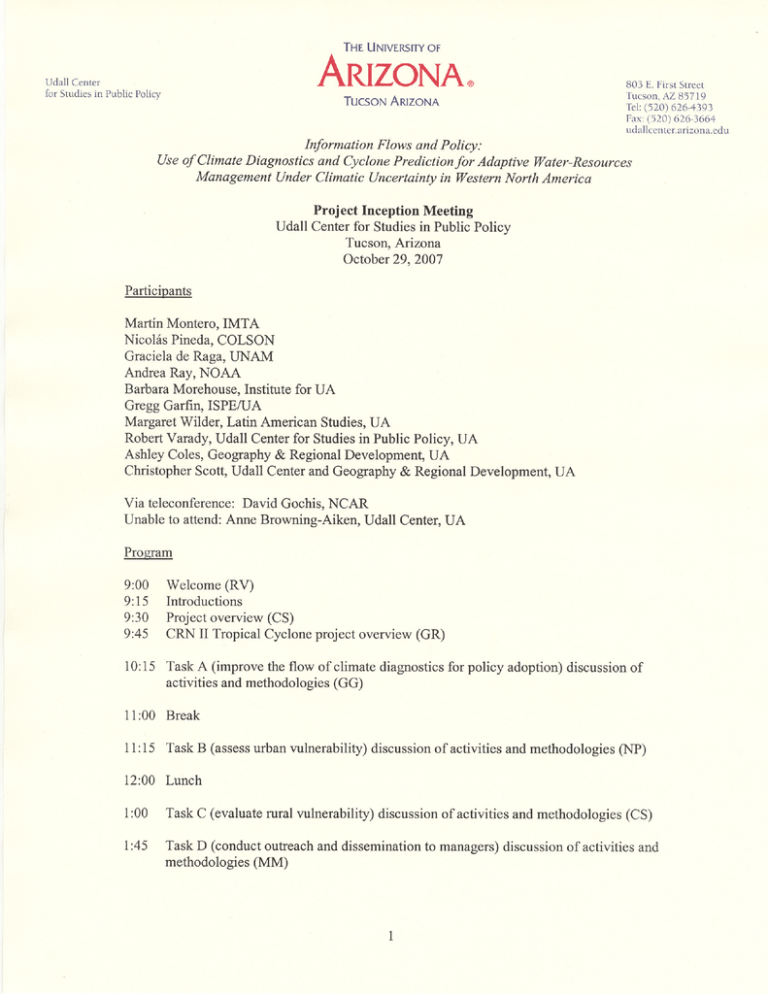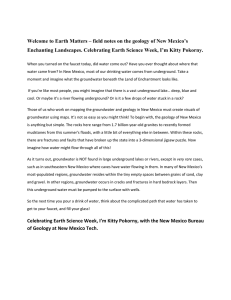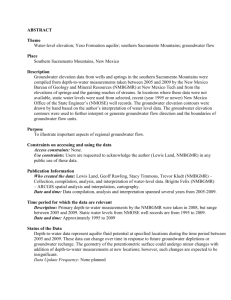Document 14234490
advertisement

Information Flows and Policy: Use of Climate Diagnostics and Cyclone Prediction for Adaptive Water-Resources Management Under Climatic Uncertainty in Western North America Minutes of the Project Inception Meeting, October 29, 2007 Summary: Discussion of the project tasks and linkages to other initiatives (CRNII2048, NOAA) led to preliminary identification of project outputs and next steps (see p. 5 of these minutes) Participants: Martín Montero, Nicolás Pineda, Graciela de Raga, Andrea Ray, Barbara Morehouse, Gregg Garfin, Margaret Wilder, Robert Varady, Ashley Coles, Christopher Scott, David Gochis (via telephone), Robert Merideth, Stephanie Buechler, Laura López-Hoffman. Welcome – Robert Varady welcomed everyone and noted: This IAI call – human dimensions small grant linked to existing IAI science program (thanks to Graciela de Raga) NOAA SARP project final report submitted today; new NOAA SARP proposal submitted Sept. Together, these represent the team and programmatic initiative on climate-water-decisionmaking Introductions Graciela de Raga - Center for Atmos. Sciences UNAM Mexico City – E. Pacific cyclones, cloudaerosol interactions. IAI stressed links with human dimensions Nicolas Pineda – COLSON public policy, urban water management, emerging interest in climate change and environmental factors Martin Montero – IMTA hydromet dept., NW Mexico (Martin has some background with stakeholders) focus is of interest to IMTA Chris Scott – water as the link between climate and society Gregg Garfin – strengthening links, CLIMAS. Bob further emphasized drought interest, climate outlook product Andrea Ray – NOAA Boulder, links with NAME, science-stakeholder processes, Western Water Assessment (focused on “interior west” including climate outlook product). Ashley Coles – climate hazard, risk and vulnerability; RA to work over 2 years on this project Barbara Morehouse – ISPE, Climate Assessment for SW, social-ecological resilience in US-Mex borderlands Margaret Wilder – Latin Am. Studies and Geography, water management and development (poverty emphasis) in Mexico and Central America. Stephanie Buechler – Bureau of Applied Research in Anthropology, work on gender-waterlivelihood issues, interested in gender and climate Laura Lopez-Hoffman – visiting scholar – ecology and the border, past postdoc at UNAM Robert Merideth – Udall Center, interest in publications from this project Dave Gochis – chair NAME science working group, Sonora fieldwork (via telephone link) Project Overview – Chris Scott summarized: Interdisciplinary, binational, applied research project. How do climate science and water resources shape decision making? What types of users might access this information? How does the information guide or inhibit decisionmaking? 1 Task A: Linking climate diagnostics to water resources and vulnerability, for both drought and floods. Deliverables will include a bi-national climate product. Task B: Studying urban vulnerability in terms of access to resources and information for both surface and groundwater. How do urban water resources link to rural resources? Task C: Rural vulnerability. Drought is considered a driving factor for rural groundwater, but cyclones might have an effect. Will be looking at articles found by Nicolás Pineda following Hurricane Henriette. Will also consider drought response, contingency planning. Task D: How will notions of climate and water systems be expressed in outreach and products? Who are the target users – official agencies, broader public? CRNII-2048 – Overview by Graciela de Raga: Partners – New Mexico Tech., CICESE, UNAM Centro de Ciencias de la Atmosfera, Costa Rican and Cuban partners Objectives: factors and processes of tropical cyclone intensification (= category 5 etc.); evaluate which could be more important under global change; wave impact Methodology: gridded climate models as well as ground and satellite observations Interest in bimodal summer precipitation – much less precipitation in July-August related to lower level wind speeds and direction that affects cyclone activity in terms of location, intensity, and frequency of cyclogenesis. More cyclones in September, and source of precipitation is different from that in July. Quickscat wind speed and direction modeling shows precip patterns strongly influenced by surface topography (Isthmus of Tehuantepec in southern Mexico) CENAPRED – Centro Nacional de Prevencion de Desastres – historical analysis of probability of landfall Rosengaus et al – Climate Atlas of Mexico (Graciela has pdf copy). Luis Farfan CICESE La Paz (CRNII-2048 project partner) interested in our IAI project Discussion centered on: Precip resulting from cyclones? Any seasonal historicity? Multiannual cycles? What cyclone intensity triggers hurricane watch, warning in Mexico? Links with Caribbean and North Atlantic (high pressure anomalies) Sea surface height anomalies and forcing of intensification. Larger ocean processes such as sea surface temperatures are not driving cyclogenesis, except over eddy anomalies. Lightning strike as indicator of cyclone activity, particularly precip Structural question – how does human dimensions interest of IAI (and our project) get expressed with other linkages? How are outputs tailored to specific interest of (HD) stakeholders? March 2008 meeting in Los Cabos. IAI support for training in CRNII-2048, and potential input this project could make. Task A – Gregg Garfin Border climate outlook Prototype at http://ispe.arizona.edu/climas/forecasts/borderoutlook_prototype.pdf What region of interest to this project? –Sierra Madre Oriental to the west? Executive summary with major highlights, provides temperature, precipitation, El Niño Southern Oscillation phases and implications, reservoir levels. Provide previous month and season as well as probabilistic forecast, with zoom capability Interpretive guides, caveats on use and application, FAQs usually repeated issue-to-issue in “Notas” section, with new material interpreting information presented in current issue. 2 Info needed to “prime the pump” i.e., to indicate to managers and decision-making that new possibilities exist (derived products…) How to interpret contradictory forecasts, forecast skill? Format of presentation (leading to “climate literacy”) will vary by region, not just language. IE, capacity building will be essential. Outlook on multiple time scales. CLIMAS website now in Spanish, too. User feedback thus far? Some gathered in Arizona and Mexico liked feature article, liked multiple sources of info (“honest, objective”). Dissemination – targeted vs broad media coverage? Via emails to subscribed users, sent also to selected reporters, agency (water, ag, fire) managers, cooperative extension Competing vs. strengthening alternate “official” products? SMN and CNA links in Mexico critical Difference in public perceptions between US and Mexico? Climate literacy differences. But this has not been aimed at general public, instead at managers. What target groups (audience)? Example of climate info for maize growers in Tlaxcala (Halley Eakin and Cecilia Conde) Operational continuity of the product? May be eased by quarterly dissemination. Water resources forecasts (based on hydrological modeling) – reservoir and streamflow forecasts. Is there an analogous product in Mexico? Storm and cyclone forecasts as part of the binational outlook? Graciela – yes, this should be possible. Task B – Nicolás Pineda Has focused on industrial and public water supply in Hermosillo and Cananea Prospects and agents for change and adaptation? Risks and threats? Framework of institutional analysis following Ostrom 2007: physical conditions, community attributes, rules-in-use. Evaluate based on efficiency, equity, adaptability Drought and flood – rules in use including lack of planning and no conservation Politicization and power-control management. How can climate and water info make decisionmaking more democratic, transparent? Users – profiles of urban sub-sectors and their interactions Action arena – problem perception (scarcity-waste), notions of climate change… What is known, what is not known about climate change and regional impacts? Elinor Ostrom and Oren Young’s work on institutions relevant here Networks within which actors operate (and outlook product disseminated) will be important Framework of institutional analysis (Ostrom 2007) Physical/nature, community, rules in use Action Arena – action, actors patterns of interaction outcomes evaluation criteria – efficiency, equity, adaptability Articulate what is known and what isn’t known about climate on a regional level. Will need a parallel methodology to do comparative work. Task C – Chris Scott Rural groundwater and agricultural irrigation, overexploited aquifers Difficult to measure and pinpoint usage, but can look at groundwater energy use as a proxy. Who has access to resources? Sustainability – water titling and rights, monitoring and compliance. 3 Once you have a well, do you go back to other sources? Perhaps if energy costs increase. Groundwater pumped is greater than groundwater titled (based on assessments of energy usage) Effects of nighttime tariffs and irrigation – pumping more water and pumping it faster when power is cheaper at night, so costs still increasing. How much produced for export versus domestic uses? Commodity chain analysis – Barbara. Virtual water – Mexico “importing” US rainwater and “exporting” groundwater. Where is the water coming from, all from northern Mexico desert groundwater? Coastal irrigation (groundwater) districts are geared towards export, surface water for domestic markets, further inland are more subsistence. Farmers seldom use groundwater to supplement lack of surface water on the same plot, often have a separate plot. Easier for US cities to take water from agriculture than for the same to happen in Sonora. Urban growth is faster than the national average in Sonora. Cyclone season precip – what contribution to annual water budget? But more important from a risk from extreme events analysis Equity of access to groundwater? Margaret Task D – Martin Montero Cyclones and emergency response Info for task D derived from CRNII2048 and task A Flood and water shortage forecasting. Hydrological modeling either at IMTA or ITSON? Workshops with managers Determine current policy on climatic data and contingency planning. But how to get the unpublished data? Maybe develop a partnership that exchanges information for products. Mexican products for emergency alert. Eg, Ricardo Prieto ex-IMTA analysis of precip estimates based on storm track Workshops – May 08 Hermosillo – to make stakeholders aware of climate info “classes” available, major findings of IPCC 4th Assessment, NAME forecast forum results (Gochis, Luis Farfan, Rene Lobato) Interactive workshop design on climate literacy, targeted climate-water needs by invited managers/ stakeholders. Synthesis – should start earlier than the end of the project, ie, synthesis of existing practice, info flow, etc. contributing to synthesis over the course of the project. Don’t necessarily want to produce prognostic products, just provide the ones already existing. To what extent do water and emergency managers communicate already? Possible incorporation with CISESE Take reports to users, regional managers that can disseminate the information locally. NOAA and related activities – Andrea Ray updated: Climate Prediction Program for the Americas (CPPA) – NAME results on streamflow and precip (Gochis); stream-reservoir predictions and nowcasts and forecasts of soil moisture (Lettenmaier) Hollings Scholarship intern (Michael Barnes, GRD and HWR) at NOAA Boulder Summer 08. 4 Potential Outputs – Group discussion and identification of possible collaborative papers, presentations with indicative topic areas: 1. E. Pacific cyclone prediction current and expected capabilities: communicating to water and emergency managers (Raga, Varady, Montero and others) 2. Comparative Hermosillo-Tucson urban water vulnerability assessment framework (Pineda, Morehouse and others) 3. Risk and vulnerability of Mexico's groundwater irrigation farmers (Scott, Wilder, Coles and others) 4. Agricultural-urban water interface for Sonora’s coastal tourism resort growth in Sonora (Wilder and others) 5. Agricultural surface- and groundwater management decisionmaking using forecasts (monsoon rainfall, evap demand, soil moisture) and assessment of information-decision pathways (Gochis, Scott, Montero and others) Next Steps – Chris Scott and Bob Varady, following the project timeline: November 9, 2007 – inception meeting minutes and presentations circulated November 16, 2007 – task leaders submit short (1-2 page) workplans for their tasks November 26, 2007 – compiled project workplan circulated February 24-29, 2008 – IAI project PI and data management meeting in Panama May or June, 2008 – workshop with managers (Montero) on NAM prelim forecast (Gochis, Watts?) Milestone (X), Output (O), Task (shaded) Oct. 29, 2007 inception meeting A. Climate outlook product B. Urbanization dimension C. Rural/ agricultural transformation IAI Project PI meeting in Panama D. Dissemination for improved contingency planning Outputs Nov. 2007 Feb. 2008 May 2008 Aug. 2008 Nov. 2008 Feb. 2009 May 2009 Aug. 2009 Nov. 2009 X X O (workplan) O (outlook product) Final outputs, reporting 5 O (synthesis)







